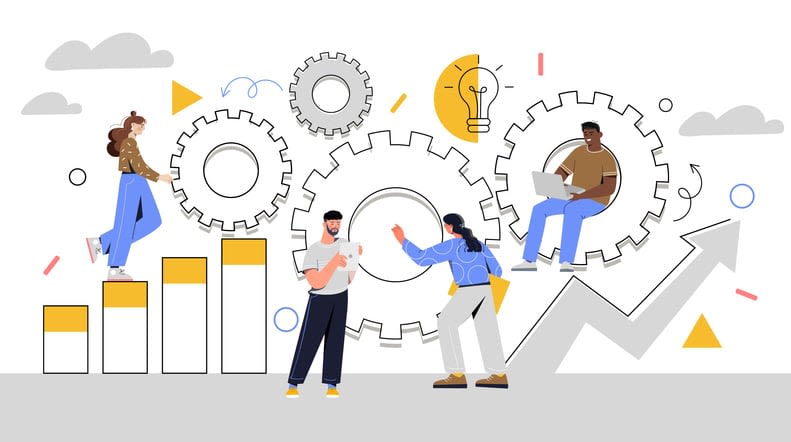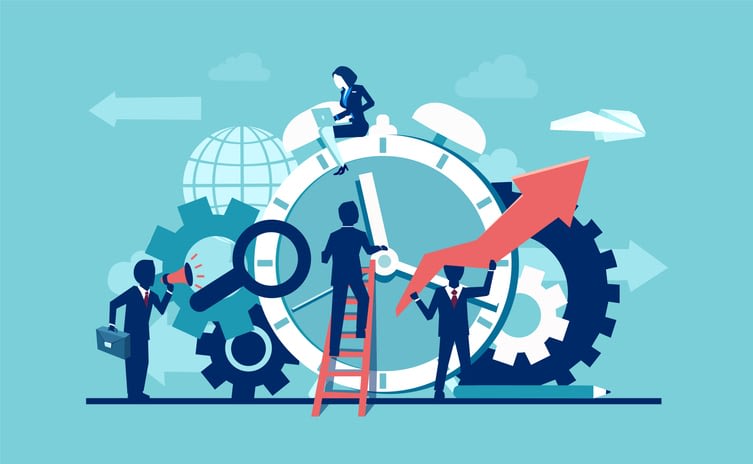How can you effectively increase your team's productivity in 2024? We provide actionable steps for getting more tasks done at a higher quality, improving your team's output, and helping reach your company's operational and financial goals.
Key takeaways
- Workplace productivity is not about how many hours spent behind the desk. Instead, it's about what you do during those hours. Being productive requires efficient task management, collaboration, and minimizing distractions.
- Adopting techniques for structured workdays, for task prioritization and scheduling tasks during peak productivity times, alongside regular breaks, drives efficiency and output.
- Studies show that workplace cultures that promote personal and professional development, balance well-being with work demands, and recognize employee efforts contribute to higher engagement, motivation, and overall productivity.
- Leveraging tools such as AI to automate tasks, Kumospace to drive employee engagement, Asana to manage tasks, Toggl to track time, will go a long way in enhancing productivity in your company.
Unlocking the potential of workplace productivity

Leadership expert Robin Sharma said “Don’t confuse activity with productivity. Many people are simply busy being busy.” Now imagine unlocking a treasure chest of productivity in your workplace, where every effort is optimized, and each minute is valued and used well. With the right approach, this can be achieved with a little effort.
By focusing on task management, reducing distractions, and managing stress, you can improve workplace productivity in a way that resonates across the entire organization. This isn’t about clocking in more hours; it’s about making those hours work harder for you.
Embracing efficient collaboration
Here’s a fact: a team with clear goals and roles is more productive. Improvements in productivity levels are more visible when the team is equipped with the right tools to collaborate. A platform like Kumospace is a great example of this, allowing employees to work and collaborate in a virtual office space. When a team can work together seamlessly, regardless of location, the collective output increases, problems are solved faster, and the individual workload becomes more manageable. In the end, it’s about harnessing the energy of the group to propel each project forward.
The role of effective tools in productivity
In the digital age, the adage “a craftsman is only as good as his tools” is still valid. The use of productivity tools can vastly improve workplace operations. Some examples of productivity tools include:
- Browser blockers to help focus
- Centralized project management tools for organization
- Artificial intelligence to speed up research and gain insights
- Cloud computing to access powerful services
With advancements in technology, the workplace of the 2020s has a powerful arsenal at its disposal to increase productivity. Equipping your team with the right tools will help them work smarter, not just harder.
Evaluating output versus input
When it comes to productivity, the equation is simple yet profound: it’s all about comparing output to input. The time it takes employees to complete tasks is a cornerstone of measuring both productivity and efficiency. By using detailed analytics, you gain invaluable insights into your workforce’s efficiency, allowing you to make informed decisions that can reshape your business’s trajectory.
The anatomy of a productive workday
The secret to a productive workday lies in its structure. You must know when to tackle the most challenging tasks, how to prioritize effectively, and when to hit pause and recharge. By adopting a technique such as the Eisenhower Matrix, you can categorize tasks and prioritize them based on importance and urgency. This sets the tone for a productive, yet manageable workday.
Structuring work hours for peak performance
Think of productivity like going surfing — it’s about finding the perfect wave. Peak productivity aligns with an individual’s unique energy states, which will naturally fluctuate throughout the day. These dips and increases in energy are known as ultradian rhythms. By keeping an hourly log of activities and energy levels, you can pinpoint when you’re most productive. Then you can schedule your most critical tasks during the hours when you feel at your best.
Harnessing the power of regular breaks
Regular breaks are not a sign of laziness but a strategy for success. They offer a chance to refresh your mind and sustain productivity. Tactics like the Pomodoro Technique, which involves working in short bursts with regular breaks, are proven to improve focus and productivity. By permitting yourself to step back, you can come back stronger and get more things done.
Cultivating a culture of productivity

A thriving work environment is one where productivity is part of the culture. When employees feel valued for their efforts, they are more likely to be engaged and productive, which translates into better financial results. High-performance cultures that focus on collaboration over competition lead to better teamwork and overall productivity. In these environments, success is celebrated and failure is analyzed dispassionately and considered a learning opportunity.
Encouraging personal and professional development
Investing in the personal and professional development of your team does more than boost job satisfaction—it increases morale and productivity. When employees feel that their personal goals and interests are supported, they experience personal growth and bring improved creative problem-solving abilities to the workplace. By considering their personal lives, leaders and teams nurture the whole person to benefit everyone in a holistic and pragmatic sense.
Balancing well-being with work demands
The balance between well-being and work demands is delicate but crucial. Besides encouraging your employees to take regular breaks, consider undertaking the following health-focused measures:
- Provide access to stress management programs
- Support exercise and physical activity
- Encourage healthy eating habits
- Promote mindfulness and meditation practices
This supports both employee well-being and improves performance.
Recognizing and rewarding productive efforts
Recognition is one of the biggest contributors to employee productivity. Celebrating small wins and establishing incentives for task completion are crucial for sustaining high motivation levels over time. When employees see a clear connection between their achievements and the organization’s objectives, they are more motivated to maintain high work standards.
Strategies for staying productive in remote work settings

Remote work presents unique challenges and opportunities for productivity. With around 30% of paid workdays done remotely as of December 2023, finding ways to stay productive outside the traditional office setting is more important than ever. While remote work can boost productivity, it requires strategic planning, adoption of the right tools, and great management.
Ensuring physical presence through virtual spaces
In a remote setting, maintaining a sense of physical presence is key to effective teamwork. Virtual office platforms like Kumospace allow remote teams to feel connected and do their best work, regardless of location. It’s a great way to bridge the gap between physical and virtual worlds and maintain effective collaboration.
Creating a dedicated home office space and setup
Creating your dream home office setup is about more than just comfort—it’s about creating an environment that fosters focus and productivity. Ensuring sufficient natural light, and using accessories such as indoor plants can work wonders for productivity.
Leveraging technology to drive productivity

As mentioned, technology can be a great enabler of productivity when used wisely. This is where automation comes into play. The more repetitive tasks you can automate, the more time you have to do strategic work. Today, there’s artificial intelligence and a variety of digital tools that can improve project management and help you assign resources more effectively.
Smart use of productivity apps
Productivity apps, including project management software, are a cornerstone of the modern work environment. Task management tools like Asana help maintain organization, while time tracking apps like Toggl offer insights into work habits and areas for improvement. Having digital assistants like these will keep you on top of your tasks.
Automating routine processes
By automating business processes, companies can:
- Serve more clients in less time
- Reduce costly errors
- Increase profit margins
- Enhance process efficiency
Technologies like Zapier and Power Automate make it easier than ever to automate repetitive tasks and focus on the bigger picture.
Integrating communication platforms
Integrating communication platforms like Kumospace, Slack and Microsoft Teams into the workplace is about more than just convenience—it’s about fostering effective teamwork. With features like video conferencing and online whiteboards, these platforms support better team collaboration and improve productivity through effective information sharing. Here’s a comparitive overview of the three communication platforms.
- A collaboration tool integrating messaging, video calls, and file sharing seamlessly within the Microsoft ecosystem.
- Provides a centralized hub for team communication and project management, enhancing productivity and collaboration.
- Its compatibility with third-party applications may be limited compared to other collaboration tools.
- A messaging platform that excels in text-based communication and file sharing.
- Facilitates quick exchanges and updates but can lead to message overload.
- Offers channels for organized discussions but lacks the feel of physical presence.
Kumospace:
- Gives you the best of both worlds with chat services, video calls, and a unique virtual office environment.
- Allows users to visit coworkers' offices for quick chats, close their own office for focused work, or join common areas to catch up with colleagues, fostering a true office experience.
- Features like spatial audio, customizable virtual offices, and built-in mini-games boost team connectivity and create a more engaging and interactive work environment.
Fine-tuning productivity metrics

Knowing productivity metrics is important for getting better. When we tailor how we measure productivity to fit the people we work with, we can get more accurate results and understand efficiency better.
Understanding total factor productivity
Total Factor Productivity (TFP) is a vital measure of efficiency, quantifying the impact of all inputs in production. It plays a significant role in economic growth and is a primary driver of GDP growth rate, highlighting its importance beyond the organizational level. In fact, productivity growth is often closely linked to improvements in total factor productivity.
Analyzing employee productivity data
Analyzing employee productivity data involves more than just tracking time—it requires a holistic approach that considers quality, absenteeism, and other variables. Establishing specific benchmarks for each position and defining the tasks entailed helps create a comprehensive productivity analysis.
Setting realistic and achievable targets
Setting realistic and achievable targets is essential for maintaining motivation and driving success. Flexibility in goal-setting allows for adjustments in response to unforeseen events or progress rates, ensuring that targets remain relevant and achievable.
Tailoring work-life balance for greater productivity

Striking the perfect balance between professional duties and personal fulfillment isn’t just about employee satisfaction—it’s a strategic move that significantly boosts focus, productivity, and their overall experience. Achieving a proper work-life balance has been shown to reduce stress, encourage better health, and lead to fewer sick days. Also, giving employees location and time freedom will allow them to work during times and in places they’re most effective.
Defining personal well-being in the workplace
Employee well-being is an essential piece of the productivity puzzle. It encompasses:
- Physical health
- Mental health
- Career satisfaction
- Personal fulfillment
By cultivating a work environment that respects and promotes personal well-being, businesses can see an uptick in performance and a healthier bottom line.
Encouraging the pursuit of personal interests
When employees are encouraged to pursue personal interests and hobbies, they can bring a renewed sense of creativity and innovation to their work. It’s about creating space for employees to recharge and providing them with the opportunity to find value beyond their jobs, which can lead to reduced stress and increased productivity.
Offering flexible policies such as unlimited paid time off or shorter work hours on Fridays can facilitate employees’ pursuit of personal interests while demonstrating a company’s commitment to their well-being.
Summary
To recap, maximizing productivity in the workplace extends far beyond the number of hours worked. It’s about embracing efficient collaboration, leveraging effective collaboration tools, and nurturing a culture that values both personal and professional development. It’s about understanding peak performance times, taking regular breaks, and setting realistic targets. For remote workers, it’s about creating a virtual presence and optimizing their home office setup for productivity. Implementing these strategies will not only improve job satisfaction and work environment but also boost the overall health of your organization.
Frequently Asked Questions
Productivity is defined as the rate at which goods and services are produced relative to the amount of inputs used, such as labor, capital, and resources. It can also be measured as the amount of work completed over a specific period.
Employee productivity is crucial as it leads to better outcomes, reduced stress levels, and an improved workplace environment, resulting in achieving company goals and boosting morale.
Virtual office spaces like Kumospace improve productivity by providing a virtual environment that promotes collaboration and communication among team members. By offering features such as customizable virtual spaces, spatial audio, and integrated task management, Kumospace enables teams to work together efficiently regardless of physical location.
Absolutely, taking scheduled breaks, brief walks, or mini-naps can refresh the mind and improve concentration, ultimately leading to more effective work periods.
When designing a home office, prioritize comfort and ergonomics to promote productivity and well-being. Ensure adequate lighting, preferably natural light, to reduce eye strain and create a pleasant working environment.





